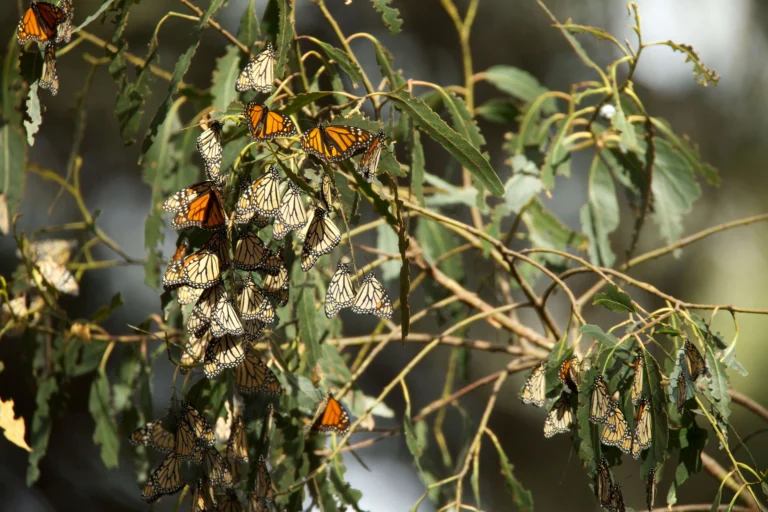A Detailed Step-By-Step Guide To Raising Monarch Butterflies
Raising monarch butterflies involves understanding their life cycle from egg to adult. Collect eggs or caterpillars, set up a safe habitat, and feed them milkweed. Monitor their growth through the caterpillar, chrysalis, and butterfly stages. It’s vital for conservation and can be done indoors or outdoors. Check legalities in places like California and ensure ethical practices.
Table of Contents
Introduction
The world of butterflies is vast, but the Monarch butterfly holds a special place in many hearts. With vibrant orange and black wings, they’re not only a delight to observe but are also crucial for our ecosystem.
The process of raising these beautiful creatures is not just a hobby but a step towards their conservation. As their habitats diminish, the role humans play in raising and protecting them becomes even more vital.
Is it Good to Raise Monarch Butterflies?
It sure is! By raising monarch butterflies, we can help increase their numbers, which have been declining due to various reasons, including habitat loss and climate change.
Plus, the entire process of observing their life cycle – from a tiny egg to a beautiful butterfly – is educational and immensely satisfying.
There are, however, challenges to be aware of, such as ensuring they’re free from diseases and have a proper diet.
Did you know that monarch butterflies are poisonous? Their unique diet contributes to their toxic nature, which helps deter predators.
Can I Raise Monarch Butterflies Legally?
Most people can indeed raise monarch butterflies, but a common question that arises is about the legality, especially considering phrases like “Is it illegal to raise monarch butterflies.”
The good news? Raising monarchs is generally legal, especially if it’s for educational purposes or personal enjoyment.
However, there can be specific guidelines or rules in some areas. For instance, in California, you might need permits if you’re releasing a large number of butterflies. So, always ensure you check local regulations.
Understanding the Life Cycle of Monarch Butterflies
Before you dive into the world of raising monarchs, understanding their life cycle is crucial. This cycle consists of four primary stages:
- Egg: The starting point. A tiny, white dot is usually found beneath milkweed leaves.
- Larva (Caterpillar): Once the egg hatches, a caterpillar emerges. This stage involves rapid growth, and you’ll see them munching away at milkweed.
- Pupa (Chrysalis): After the caterpillar is done growing, it transforms into a chrysalis. Here, it undergoes its magical transformation into a butterfly.
- Adult butterfly: The final stage. A glorious monarch butterfly ready to fly, mate, and lay eggs to start the cycle all over again. Dive deeper into the monarch butterfly’s lifecycle & lifespan to get a comprehensive view of their life stages.
Step-by-Step Guide on How to Raise Monarch Butterflies
Acquiring Monarch Eggs or Caterpillars
Raising Monarch Butterflies from Eggs:
The initial phase of raising monarchs is to locate their eggs. Typically, these can be found underneath the leaves of milkweed plants, which are the primary food source for monarch caterpillars.
Learn more about monarch butterfly eggs to ensure successful collection and care.
When identifying eggs, they look like tiny, pale pearls. To collect them, carefully snip the leaf or portion of the leaf with the egg and place it in a secure container, ensuring that it’s free from harmful insects or parasites.
Raising Monarch Butterfly Caterpillars:
Once you have the eggs, your journey in raising the caterpillars begins. As the eggs hatch, ensure the caterpillars have ample milkweed to feed on.
They grow quickly, so check daily to ensure they have enough to munch on.
Remember to keep the environment clean, removing any waste they produce. This helps in keeping diseases at bay.
Setting Up a Monarch Nursery
Monarch Butterfly Raising Kit:
For beginners, buying a monarch butterfly raising kit can be a boon. It’s also essential to know the right monarch butterfly plants to keep them thriving.
These kits typically include netted cages (which allow airflow), milkweed (caterpillar food), and resources with instructions. Using a kit can make the process more straightforward and error-free.
Raising Monarch Butterflies Indoors vs. Outdoors:
Both indoor and outdoor setups have their advantages. Indoors provide controlled environments, making it easier to protect caterpillars from predators.
Meanwhile, raising outdoors can offer a more natural experience, but you’ll need to be vigilant about potential threats, such as wasps or spiders. Choose based on your comfort and ability to monitor them.
Supplies
Besides the kit, there are essentials to keep in mind. A spray bottle for misting, additional milkweed plants, a small dish for water, and a clean cloth for the base of your setup are all crucial to creating a thriving nursery.
Caterpillar Care & Diet
Milkweed is the only diet for monarch caterpillars. Ensure you provide fresh leaves, replacing old or dried ones, so they can feed and grow healthily.
Raising Monarch Butterflies Inside
If you’ve chosen to raise your monarchs indoors, monitor their growth and stages of molting. Keep the environment clean, maintain a steady temperature, and ensure there’s enough humidity. A light misting can help maintain ideal conditions.
Transitioning to Chrysalis: Raising Monarch Butterfly Chrysalis
As the caterpillar reaches its full size, it starts looking for a suitable place to begin its next phase: becoming a chrysalis. You’ll notice the caterpillar hanging in a “J” shape, which is a clear sign it’s ready for this transition.
It’s essential during this time to ensure the environment remains calm and undisturbed. Once the caterpillar forms a green, jewel-like chrysalis, the metamorphosis begins inside, leading the caterpillar towards becoming a beautiful butterfly.
For a closer look at this transformation, explore the monarch butterfly chrysalis stage in detail.
Welcoming the Adult Monarch
After some time, the chrysalis becomes translucent, hinting that the butterfly is ready to emerge. It’s a magical moment! Once the monarch butterfly emerges, it will need some time for its wings to dry and strengthen.
It’s vital not to touch or disturb the butterfly during this period. When the monarch starts opening and closing its wings, it’s a sign it’s ready to explore the world.
Best Time to Raise Monarch Butterflies
The ideal time for raising monarch butterflies is during the warmer months when milkweed is abundant. Releasing them should ideally be on a sunny, calm day, allowing them to comfortably adjust to their surroundings.
Releasing Monarch Butterflies
Before release, pick a location close to milkweed or flowering plants, as they provide the newly-emerged monarch with nourishment. Gently take the butterfly on your finger and let it decide when to take its first flight. Remember, this is a moment to cherish, so take it in.
Troubleshooting and Overcoming Challenges
While the experience is rewarding, there are challenges to consider, like diseases and predators. Regular cleaning and monitoring can prevent most issues. It’s also essential to be informed about potential diseases like OE (Ophryocystis elektroscirrha) and how to prevent them.
Raising Monarch Butterfly for Kids
For the young enthusiasts, raising monarchs can be an educational and fun activity. The key is to simplify the process. Using visual aids, interactive tools, and perhaps a diary to note observations can make the experience more kid-friendly.
Beyond Raising: Conservation and Community Involvement
Raising Monarch Butterflies in Different States
Every state has its unique climate and environment. For instance, in Florida, the warmer climate means monarch butterflies can be spotted throughout the year, while in Michigan, it’s more seasonal due to the colder weather.
Over in California, the western monarchs migrate to the coast during the winter. No matter where you are, it’s essential to understand the local monarch populations and adapt your raising techniques accordingly.
Monarch Butterflies Raised in Captivity
There’s a mix of challenges and rewards when raising monarchs in captivity. On the one hand, you’re protecting them from predators and ensuring a higher survival rate. On the other hand, butterflies raised indoors might not develop the same resilience as their wild counterparts.
So, always be gentle and aim to recreate a natural environment as closely as possible.
Predators and Threats
One of the challenges faced by these beautiful insects is the presence of natural predators. These include:
- Wasps: These can pose a threat to caterpillars. To deter them, it’s essential to ensure that your butterfly nursery is securely covered and checked regularly.
- Spiders: They can sometimes make webs inside habitats. Regular cleaning and monitoring will help ensure caterpillars and chrysalises remain safe.
- Ants: These small creatures can also be a danger. To keep them at bay, consider placing the feet of your butterfly habitat in shallow dishes of water, acting as a natural barrier.
For the healthiest monarchs, it’s crucial to be vigilant and maintain a safe environment, free from these predators.
Frequently Asked Questions
Is it OK to touch a monarch butterfly?
Yes, but with care. Their wings are delicate. If you must handle one, gently grasp the leading edge of both wings to minimize damage.
How long before a monarch butterfly can fly?
After emerging from the chrysalis, a monarch butterfly will need several hours to let its wings dry and harden before it can fly effectively.
How do you raise monarch butterflies outdoors vs. indoors?
Raising monarchs outdoors can expose them to natural conditions, but also to predators. Indoors, you can better control the environment, ensuring a higher survival rate.
What’s the best time to raise monarch butterflies?
Monarchs have specific breeding seasons linked to their migration patterns. It’s usually best to raise them in late spring to early summer, coinciding with these patterns.
Can I get a kit for raising monarch butterflies?
Yes, there are monarch butterfly-raising kits available, providing you with essential supplies and guidelines to help you start.
How do I start raising monarch butterflies from caterpillars or eggs?
Begin by sourcing monarch eggs or caterpillars, then setting up a safe habitat for them. Ensure they have a constant supply of milkweed, their primary food source.
Monitor their growth, from caterpillar to chrysalis, then to butterfly, ensuring they’re protected from threats.
Is raising monarch butterflies in different states like California, Florida, or Michigan different?
While the basic principles remain the same, local conditions, regulations, and availability of milkweed might differ. Always check state-specific guidelines and conditions.
Conclusion
YouTube Raising Monarch Butterflies
For those who prefer visual learning, there are many educational and engaging videos on YouTube. These videos can provide a first-hand look into the monarch raising process, offering tips, tricks, and insights from experienced raisers.
Books on Raising Monarch Butterflies:
If you’re an avid reader, consider diving into “How to Raise Monarch Butterflies by Carol Pasternak”. This book, among others, provides in-depth knowledge, making the experience of raising these beautiful creatures even more enriching.
To wrap up, raising monarch butterflies is more than just a hobby—it’s a testament to the wonders of nature and the pivotal role humans can play in conservation. Each butterfly raised and released is a step towards preserving and appreciating the delicate balance of our ecosystem.
The journey of nurturing a tiny egg into a majestic butterfly is truly unique and rewarding, reminding us of the beauty and miracles present in nature.
Embrace the experience, learn along the way, and always remember: you’re making a difference, one butterfly at a time.


